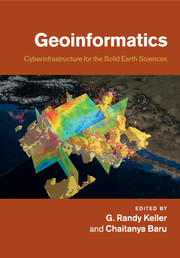Book contents
- Frontmatter
- Contents
- List of contributors
- Preface
- Introduction
- Part I Case studies from other disciplines
- Part II Modeling software and community codes
- 5 Development, verification, and maintenance of computational software in geodynamics
- 6 Parallel finite element modeling of multi-timescale faulting and lithospheric deformation in western USA
- 7 Next-generation plate-tectonic reconstructions using GPlates
- Part III Visualization and data representation
- Part IV Knowledge management and data integration
- Part V Web services and scientific workflows
- Part VI Emerging international and other efforts
- Index
- Plate section
- References
5 - Development, verification, and maintenance of computational software in geodynamics
from Part II - Modeling software and community codes
Published online by Cambridge University Press: 25 October 2011
- Frontmatter
- Contents
- List of contributors
- Preface
- Introduction
- Part I Case studies from other disciplines
- Part II Modeling software and community codes
- 5 Development, verification, and maintenance of computational software in geodynamics
- 6 Parallel finite element modeling of multi-timescale faulting and lithospheric deformation in western USA
- 7 Next-generation plate-tectonic reconstructions using GPlates
- Part III Visualization and data representation
- Part IV Knowledge management and data integration
- Part V Web services and scientific workflows
- Part VI Emerging international and other efforts
- Index
- Plate section
- References
Summary
Introduction
Research on dynamical processes within the Earth and planets increasingly relies upon sophisticated, large-scale computational models. Improved understanding of fundamental physical processes such as mantle convection and the geodynamo, magma dynamics, crustal and lithospheric deformation, earthquake nucleation, and seismic wave propagation, are heavily dependent upon better numerical modeling. Surprisingly, the rate-limiting factor for progress in these areas is not just computing hardware, as was once the case. Rather, advances in software are not keeping pace with the recent improvements in hardware. Modeling tools in geophysics are usually developed and maintained by individual scientists, or by small groups. But it is difficult for any individual, or even a small group, to keep up with sweeping advances in computing hardware, parallel processing software, and numerical modeling methodology.
We will focus on the challenges faced by computational geophysics and the response of a community initiative in the United States called the Computational Infrastructure for Geodynamics (CIG). Instead of reviewing all of the activities CIG has been involved with, we will focus on just a few so as to describe the multiple ways that a virtual organization developed and used software within the rapidly evolving backdrop of computational science. We will focus on the scientific topics of mantle convection, tectonics, and computational seismology, although CIG has also been deeply involved with magma dynamics and the geodynamo.
Mantle convection is at the heart of understanding how the Earth works, but the process remains poorly understood at best.
- Type
- Chapter
- Information
- GeoinformaticsCyberinfrastructure for the Solid Earth Sciences, pp. 49 - 67Publisher: Cambridge University PressPrint publication year: 2011
References
- 1
- Cited by

